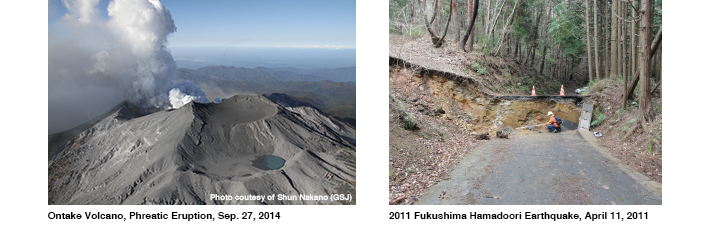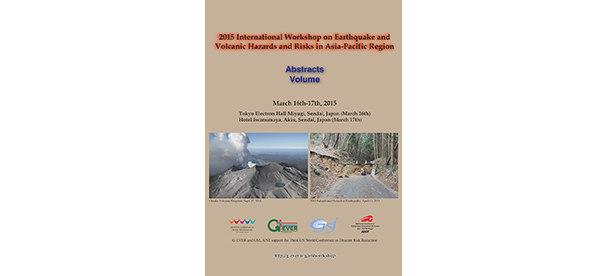


- Date:
- March 16, 2015 (Mon)
- Organizers:
- G-EVER Consortium
- Geological Survey of Japan, National Institute of Advanced Industrial Science and Technology (AIST)
- The 3rd UN World Conference on Disaster Risk Reduction:
- The Third UN World Conference on Disaster Risk Reduction (WCDRR) will be held to consider and adopt the post-2015 framework for disaster risk reduction from 14 to 18 March 2015 in Sendai City, Japan. The G-EVER Consortium and the Geological Survey of Japan are going to organize the “2015 International Workshop on Earthquake and Volcanic Hazards and Risks in Asia-Pacific Region” in Sendai Japan during the 3rd UN World Conference on Disaster Reduction as one of the major public forum.
- Purpose:
- Asia-Pacific Region is an area with high risk of catastrophic natural disasters such as earthquakes, tsunamis and volcanic eruptions. In today's highly globalized economy, disaster occurrence can create unpredictable turmoil worldwide, not just in the directly affected area. Countermeasures against these large-scale disasters are crucial for the sustainable development of the global economy to ensure human security. Thus it is imperative to establish an effective international framework where we collaborate and develop an efficient system of gathering information on disaster mitigation in the Asia-Pacific Region. Enhancing the exchange and sharing of various information on seismic and volcanic eruptions, and the formulation of international standards for database, data exchange and disaster risk assessment are essential for future hazards mitigation. The International Workshop on Earthquake and Volcanic Hazards and Risks in Asia-Pacific Region aims (1) to provide venue for the presentation of current research works on earthquake and volcanic hazard mitigation in the region, and (2) to provide a forum for an extensive exchange of ideas in the development of international standards on data compilation, hazard and risk assessment.
- Schedule:
- March 16, 2015 (Mon) 9:15- Registration
- March 16, 2015 (Mon) 9:40-18:45 Presentations

- 2015 International Workshop on Earthquake and Volcanic Hazards and Risks in Asia-Pacific Region Abstracts Volume (PDF, 4.2MB)
- Invited Speakers:
- Patrick McKeever (Cheif of Earthquake and Geohazard Risk Reduction Section, UNESCO)
- Iskandar Zulkarnain (Chairman of Indonesian Institute of Sciences, LIPI, Indonesia)
- Adichat Surinkum (Director of Coordinating Committee for Geosicence Programms in East and Southeast Asia, CCOP)
- Ross Stein (Global Earthquake Model, GEM Cofounder, U.S. Geological Survey)
- Renato Solidum (Director of the Philippine Institute of Volcanology and Seismology, PHIVOLCS, Philippiine)
- Supriyati Andreastuti (Center for Volcanology and Geological Hazard Mitigation, CVGHM, Geological Agency, Indonesia)
- Zhongliang Wu (Director of the Institute of Geophysics, China Earthquake Administration, and executive committee member and past president of the IASPEI)
- David Johnston (GNS Science, New Zealand, Chair of the Scientific Committee, Integrated Research on Disaster Risk, IRDR, Director of the Joint Centre for Disaster Research)
- Graham Leonard (GNS Science, New Zealand, Leader of Cities and Volcanoes Commission, IAVCEI)
- Nguyen Hong Phuong (Vice President of Earthquake Information and tsunami warning center, Vietnam Academy of Science and Technology, VAST)
- Cheng-Horng Lin (Academia Sinica, Taiwan)
- Christina Widiwijayanti (Earth Observatory of Singapore, EOS)
- Marco Pagani (Seismic Hazard Team, Global Earthquake Model, GEM Foundation, Italy)
- Kuniyoshi Takeuchi (International Centre for Water Hazard and Risk Management, ICHARM, PWRI)
- Masato Iguchi (Disaster Prevention Research Institute, DPRI, Kyoto University, President of Volcanological Society of Japan )
- Ken Xiansheng Hao (Global Earthquake Model, GEM Science Board Vice-Chair, National Research Institute for Earth Science and Disaster Prevention, NIED)
- Kentaro Imai (Tsunami Engineering Laboratory, International Research Institute of Disaster Science, Tohoku University)
- Program: download (PDF, 109 KB)
- March. 16 (Mon)
- Welcome address:
- Chair: Yasuto Kuwahara
- 9:40-9:50 Eikichi Tsukuda (Director General, GSJ, AIST, G-EVER Consortium President)
- Session 1: International Activities for Disater Mitigation
- Chair: Yasuto Kuwahara and Naoji Koizumi
- 9:50-10:05 International Geoscience Programme and Global Geoparks: Looking Towards The Future
- Patrick McKeever (UNESCO)
- 10:05-10:15 Community-based Geo-hazard Mitigation in CCOP countries
- Adichat Surinkum (CCOP)
- 10:15-10:30 Mitigation of Earthquake and Related Hazards for Risk Reduction in Indonesia: Challenging from Research to Policy
- Iskandar Zulkarnain (LIPI), Danny Hilman Natawidjaja and Adrin Tohari
- 10:30-10:55 Building community resilience to natural hazards in Wellington, New Zealand: linking global programmes to local action
- David Johnston (JCDR, GNS Science), Emma E. H. Doyle, Bruce Pepperell, Dan Neely and Julia Becker
- 10:55-11:20 Recent volcanic and earthquake hazard and risk activities at GNS Science, New Zealand, and the Cities and Volcanoes Commission of IAVCEI
- Graham Leonard (JCDR, GNS Science)
- 11:20-11:30 [Coffee Break] (Group Photo)
- Chair: Yasuto Kuwahara and Naoji Koizumi
- 11:30-11:55 Disaster Loss Data for Risk Assessment and Achieving Post-2015 Targets for Disaster Risk Reduction
- Kuniyoshi Takeuchi (ICHARM, PWRI)
- 12:20-12:45 The OpenQuake-engine hazard component: current status and new experimental features
- Marco Pagani (GEM), Graeme Weatherill, Julio Garcia, Yen-Shin Chen, Fabrice Cotton, Ken Hao and Hiroyuki Fujiwara
- 12:45-13:30 [Lunch] & Poster Session Core Time
- Session 2: Earthquake and Volcanic Hazards and risk in Asia
- Chair: Yuzo Ishikawa and Shinji Takarada
- 13:30-13:55 G-EVER Consortium activities: towards earthquake and volcanic hazards risk mitigation in Asia-Pacific region
- Shinji Takarada (GSJ, AIST), Joel Bandibas, Yuzo Ishikawa and G-EVER Promotion Team
- 13:55-14:20 Earthquake and volcanic hazards and risk assessment efforts in the Philippines
- Renato Solidum (PHIVOLCS)
- 14:20-14:45 The important of earthquake and volcano hazard mappings in disaster risk reduction and its implementation to spetial planning
- Supriyati Andreastuti (CVGHM) and Sri Hidayati
- 14:45-15:10 Recent development of WOVOdat - The global volcano unrest database - as a resource to improve eruption forecasts
- Christina Widiwijayanti (EOS), Fidel Costa, Thin Zar Win Nang, Karine Tan, Chris Newhall, and Antonius Ratdomopurbo
- 15:10-15:35 Scientific products for the multi-scale seismic hazard and risk assessment in China: present status and future prospects
- Zhongliang Wu (CEA), and the Group for the 13th Five-Year Plan (2016~2020) for Earthquake Monitoring and Forecast of the CEA
- 15:35-16:15 Poster Session Core Time & [Coffee Break]
- Chair: Yuzo Ishikawa and Shinji Takarada
- 16:15-16:40 Seismological Evidence of Plumping System beneath the Tatun Volcano Group, Northern Taiwan
- Cheng-Horng Lin (TVO, Academia Sinica)
- 16:40-17:05 Updated Probabilistic Seismic Hazard Maps of Vietnam
- Nguyen Hong Phuong (VAST) and Pham The Truyena
- 17:05-17:30 How can the world learn the lesson from Tohoku Earthquake? : Epistemic uncertainty aspects
- Ken Xiansheng Hao (NIED) and Hiroyuki Fujiwara
- 17:30-17:55 International collaboration for mitigation of volcano hazard in Asia
- Masato Iguchi (SVRC, DPRI, Kyoto Univ.)
- Chair: David Johnston, Ross Stein and Shinji Takarada
- 17:55-18:35 General Discussion
- 18:35-18:45 Closing Remarks
- Yasuto Kuwahara (GSJ, AIST)
- Poster Session: Large-scale Earthquakes and Volcanic Eruption [Core Time: 12:45-13:30, 15:35-16:15]
- P1 The Development of Tsunami Trace Database on the Coast of Japan
- Fumihiko Imamura, Kentaro Imai (Tohoku Univ.), Yayoi Haga and Masami Sato
- P2 Try to draw the volcanic eruptions and earthquake activity in the same figure : part 1 in and around Japan
- Yuzo Ishikawa (GSJ, AIST)
- P3 Caldera forming eruptions and their characteristics of preceding activities during the last 1000 years in Sunda Arc, Indonesia
- Ryuta Furukawa (GSJ, AIST), Akira Takada and Oktory Prambada
- P4 Observation of groundwater and crustal deformation for forecasting the Tokai, Tonankai and Nankai earthquakes in Japan
- Naoji Koizumi (GSJ, AIST) and Norio Matsumoto
- P5 Variability of slips at point on fault in each of successive surface-rupturing earthquakes: examples from paleoseismology of surface ruptures in recent inland earthquakes in Japan
- Tadashi Maruyama (GSJ, AIST)
- P6 Data collection for estimation of surface deformation by faulting
- Masayuki Yoshimi (GSJ, AIST), Hidetaka Saomoto, Haruo Horikawa and Shintaro Abe
- P7 G-EVER Asia-Pacific Region Earthquake and Volcanic Hazard Information System and the CCOP Geoinformation Sharing Infrastructure for East and Southeast Asia
- Joel Bandibas (GSJ, AIST) and Shinji Takarada
- P8 Analog experiments for outreach program to understand fundamental processes of volcanic hazard
- Akira Takada (GSJ, AIST), Ryuta Furukawa, Teruki Oikawa, Seiko Yamasaki, Shinji Takarada and Shogo Komori
- P9 International activity of Geological Survey of Japan, AIST
- Toshihiro Uchida (GSJ, AIST) and Junko Hara
- March. 17 (Tue) 9:00-16:50 [Invited Participants only]
- Current Situation and Future Strategy of the Earthquake and Volcanic Hazards and Risk in Asia-Pacific Region
- Admission:
- Free
- Instruction for Oral and Poster presentations:
- Oral presentation: Please prepare a PPT file (MS-Power Point 2007 or 2012 compatible) in a USB memory. The PPT file should be uploaded in the G-EVER's laptop computer (windows) before starting the author's session. (If the author prefer to use own laptop computer due to movie or other reasons, please let us know)
- Poster presentation: Poster size is 150cm (vertical) x 90cm (width). Display your poster until 9:30 on March 16 and remove it until 19:00. Tapes to put the poster on the board will be provided. Poster session core time will be 12:45-13:30 and 15:35-16:15. Free drinks (coffee and tea) and cookies will be served during the poster sessions.
